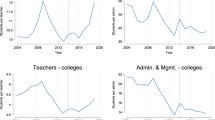Abstract
Despite numerous speculations regarding the rampant growth of administrative sectors in higher education little concrete research has been generated. The current study takes an objective look at the increase in numbers of administrative personnel at four regional universities in Kentucky during an 11-year period. A tally of the numbers of titles included in university personnel rosters during that time indicates that the growth in numbers of administrators and administrative staff exceeded that of most other indicators of university growth such as numbers of faculty, numbers of students, and numbers of graduates. Suggestions are offered for the causes of the marked growth in administrative sectors. The methodology used in this study could be replicated in other types of institutions.
Similar content being viewed by others
References
American Association of University Professors, Committee Z on the Economic Status of the Profession.Annual survey of academic salary and fringe benefit data for the academic year 1972–73. Washington, D.C., 1973.
Anderson, T. and Warkov, S. Organizational size and functional complexity: a study of administration in hospitals.American Sociological Review 1961,26 23–28.
Bendix, R.Work and authority in industry. New York: John Wiley, 1956.
Blau, P. M.The organization of academic work. New York: John Wiley, 1973.
Boland, W., and Boland, M. Population size and administration in institutions of higher education.American Sociological Review 1965,30 252–255.
Duke University, Central Administration.Interim report. Durham, NC: Duke University, 1970. (ERIC Document Reproduction Service No. ED 042418)
Council on Higher Education,A system of higher education in Kentucky including university mission statements. Frankfort, Kentucky, 1977.
Duryea, E. C. Evolution of university organization. In James A. Perkins (Ed.),The university as an organization. New York: McGraw Hill, 1973.
Gill, N.The relationship between the size of urban school systems and certain characteristics of their administrative staffs. Unpublished Master's Thesis, The University of Alberta, Edmonton, 1967.
Gittell, M., and Hollander, T. E.Six urban school districts: a comparative study of institutional response. New York: Praeger, 1968.
Good, Charles V. (Ed.).Dictionary of education. New York: McGraw Hill, 1945.
Haas, E., Hall, R., and Johnson, N. J. The sign of the supportive opponent in organizations: a multi-organizational analysis.Social Forces 1963,42 9–17.
Haire, M. Biological models and empirical histories of the growth of organizations. In Mason Haire (Ed.),Modern Organization Theory. New York: John Wiley, 1959.
Holdaway, E. A., and Blowers, T. A. Administrative ratios and organization size: a longitudinal examination.American Sociological Review 1971,36 278–286.
Indix, B. P. The relationship between organizational size and supervision ratio.Administrative Science Quarterly 1964,9 301–312.
Klatzsky, S. R. Relationship of organizational size to complexity and coordination.Administrative Science Quarterly 1970,15 428–438.
Lewis, L. S.Scaling the ivory tower: merit and its limits in academic careers. Baltimore: The Johns Hopkins Press, 1975.
Lindenfeld, F. Does administrative staff grow as fast as organization?School Life 1961,43 20–23.
Lucas, M. The way we grow.Faculty Senate Communication Committee News-letter. Bowling Green, KY: Western Kentucky University, no date.
Lunsford, T. F. Authority and ideology in the administered university. In Carlos E. Kruytbosch and Sheldon L. Messinger (Eds.),The state of the university: authority and change. Beverly Hill, CA: Sage, 1970.
McGrath, E. J.The evolution of administrative offices in institutions of higher education in the United States from 1860 to 1933. Doctoral dissertation, University of Chicago, 1936.
Newburn, H. K. Faculty and administration in the governance of the university,Educational Record, Summer 1965, pp. 256–264.
Partridge, F. A.The evolution of administrative offices in liberal arts colleges from 1875 to 1933. Unpublished Master's Thesis, University of Chicago, 1934.
Pondy, L. R. Effects of size, complexity and ownership on administrative intensity.Administrative Science Quarterly 1969,14 47–60.
Rehder, R. R.The bureaucratic drift in the governance of higher education: insights from organizational theory. The Robert O. Anderson Graduate School of Management, Working Paper No. R 783, 1978.
Starbuck, W. H. Organizational Growth and Development. In J. G. March (Ed.),Handbook of Organizations. Chicago: Rand McNally, 1965.
Terrien, F. W. and Mills, D. S. The effect of changing size upon the internal structure of organizations.American Sociological Review 1955,20 11–13.
Tosi, H. and Platt, H. Administrative ratios and organizational size.Academy of Management Journal 1967,10 161–168.
Author information
Authors and Affiliations
Rights and permissions
About this article
Cite this article
Brown, A. How the administration grows: A longitudinal study of growth in administration at four universities. Res High Educ 14, 335–352 (1981). https://doi.org/10.1007/BF00976683
Issue Date:
DOI: https://doi.org/10.1007/BF00976683




